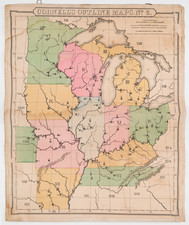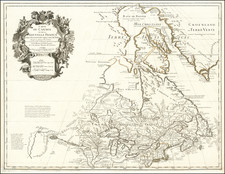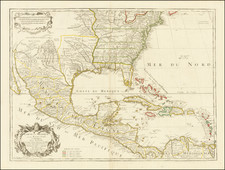A fine example of the 1878 edition of the W.W. De Lacy map of Montana, referred to by Carl Wheat as "one of the greate maps in the record of Western Cartography."
De Lacy issued his first monumental map of of Montana Territory and parts of Wyoming in 1865. The first edition of the map is known in 3 editions, as noted by Saunders ( Imago Mundi, Vol 54, pp 129-134). De Lacy, a civil engineer and West Point graduate, had been commissioned by the Montana Territorial Legislature to produce a of the Territory at its first meeting in the summer of 1864, following the formation of the Territory on May 16, 1864.
As noted by Saunders, two copies of the manuscript map were created by De Lacy, one of which "shipped east for printing." Within the first year after its creation, printed editions of the map were published by Julius Hutawa in St. Louis and by Rae Smith of New York. The Smith edition includes an inset "Map showing the Routes from the Missouri River to Fort Laramie." Saunders notes two states of the Smith edition, one with no copyright and one with a copyright by S.T. Hauser. For many years, it was believed that the Smith map was the first printed edition of the map and was thereafter copied by Hutawa, but Saunders argues persuasively that the Hutawa is in fact the original source, which was copied by Smith (Saunders notes that Hutawa uses the earliest name for Helena, Prickly Pear City, whereas Smith uses a later name, Montana City. Hutawa also correctly spells Sublette's Road, whereas Smith erroneously includes Sablette's Road).
In 1870, GW & CB Colton issued a much enlarged and updated version of the map and includes an inset map of the Northwest. The 1870 edition includes a list of sources for the De Lacy map, including the Stevens Surveys, Mullans Surveys, Raynolds Surveys, and personal surveys of 1859-1869, the Clift Surveys of the route to Mussellshell, Cooke & Folsom's explorations to Yellowstone Lake and reliable information derived from Miners, Surveyors and Explorers. De Lacy's Lake (now Shoshone Lake) appears, along with De Lacy's route of exploration in 1863 through the Grand Canyon of the Snake River, Jackson Hole, and across a divide to the South Fork of Firehole River, toward Bozeman via the West Gallatin River.
De Lacy's depiction of the Cooke & Folsom explorations makes this one of the most important early Yellowstone maps, tracing the route from Bozeman to Yellowstone, below its 1st Canyon, through the 2nd Canyon and around the east edge of the 3rd Canyon, past Burning Springs, Sulpher Sprints and Hot Sulpher Springs to the Upper and Lower Falls. This makes De Lacy's map the first to report on both the falls and the varied thermal phenomena in the area of Yellowstone Lake.
Wheat notes that while De Lacy's map is important for the information in Yellowstone, within the boundaries of Montana it is equally impressive. The map depicts ing reat detail the towns and mining camps of the Territory, early counties and Indian Resevations, military posts and Indian Agencies. It highligs the routes of Captain Clifton from Fort Howie to Musselshell City in 1869 and Fort Hawley. A Road to Minnesota is the Fiske Road from Fort Benton via the Milk to the Missouri River.
Glass Bluffs is named, a reference to Hugh Glass, killed on the Yellowstone River in 1833 by Arikaras Indians). The Bridger and Bozeman Trails are shown, with several abandoned forts noted along the way. The Colton edition of the map extends further west and therefore includes information not on the 1865 map and only available in De Lacy's 1866 manuscript map, including his treatment of the road system in Idaho and Eastern Washington.
The first edition of Colton's map was issued in 1870. Later editions of the map appeared in 1871, 1872, 1874, 1875 and 1878.
One of the first changes which appear in the map is the correction of the Idaho boundary. In the 1870 edition, the borders is shown at 117 degrees west, whereas in all subsequent editions, the boundary is moved 40 minutes to the west. The later editions add a number of additional features, including the Arikarees, Gros Ventres & Mandan Indian Reservation, The Gros Ventres, Piegan, Blood, Blackfee & Crow Indian Reservation. The topography of northwest Montana and Idaho is significantly improved in the later editions and the Nez Perce reservation is added in Idaho. As a result of the Gold Discoveries on the Salmon River, significant topographical improvements are made. In Wyoming, the Snake Indian Reservation is added in later editions.
The later editions also show the progress of Township Surveys in the Territory. There is also significantly more Gold Mining activity showing in the later editions.









![History of the Expedition under the Command of Captains Lewis and Clark, to the Sources of the Missouri Thence across the Rocky Mountains and Down the River Columbia to the Pacific Ocean, Performed During the Years 1804-5-6 [with map:] Map of Lewis and Clark's Track, Across the Western Portion of North America from the Mississippi to the Pacific Ocean](https://storage.googleapis.com/raremaps/img/small/92506.jpg)



![[DeWitt Clinton Copy] An Account of Expeditions to the Sources of the Mississippi, and through the Western Parts of Louisiana, to the Sources of the Arkansaw, Kans, La Platte, and Pierre Jaun, Rivers During the years 1805, 1806 and 1807. And a Tour through the Interior Parts of New Spain. in the year 1807.](https://storage.googleapis.com/raremaps/img/small/81745.jpg)
